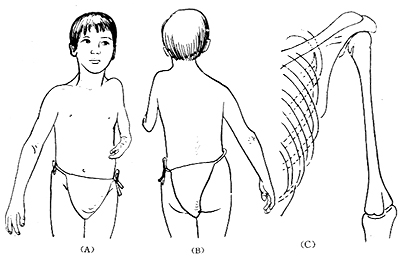| disease | Congenital Shoulder Dislocation |
Congenital shoulder dislocation is extremely rare, with only a few case reports in the literature. Only shoulder dislocations discovered at birth are considered congenital, meaning the pathological joint dislocation was already formed in utero. Clinically, most cases seen are paralytic, often caused by shoulder muscle paralysis, such as childbirth-related brachial plexus nerve injury. Traumatic shoulder dislocation in newborns almost never occurs.
bubble_chart Pathological Changes
Due to congenital absence of bony or surrounding soft tissues, the shoulder joint may experience dislocation in the anterior, posterior, and inferior directions.
bubble_chart Clinical Manifestations
The shape and functional limitations of the shoulder joint vary depending on the severity of the deformity. Underdevelopment or absence of the glenoid or humeral head can exacerbate the deformity, often accompanied by increased shoulder instability and upper limb bone malformations (Figure 1).

Figure 1 Shoulder dislocation combined with upper limb deformity
(A) Front view (B) Back view (C) Shoulder dislocation
The diagnosis can be easily made based on medical history, clinical manifestations, and X-ray films.
bubble_chart Treatment Measures
When shoulder joint function is mildly affected, surgical treatment may not be necessary, as it could lead to further loss of function. Whitman advocates for manual reduction, but post-treatment shoulder joint redislocation is very common.
Surgical treatment varies depending on the condition, including shoulder joint capsulorrhaphy, tendon transfer, shoulder joint fusion in functional position, and resection of the acromial deformity bone prominence. However, these procedures may limit shoulder joint mobility. For severe shoulder joint dysplasia, surgery is usually ineffective and cannot improve function.
bubble_chart ComplicationsCombined upper limb bone deformity.




